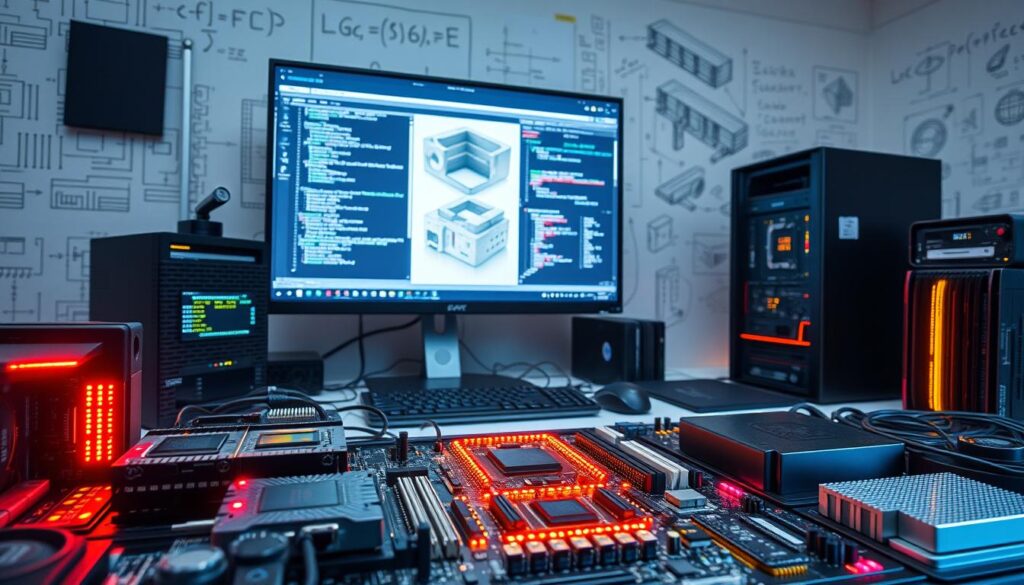Computer engineering is a dynamic field that encompasses a broad range of disciplines, including hardware engineering, network engineering, web engineering, and data engineering.
This multifaceted field is crucial in today’s technology-driven world, where the demand for innovative solutions is ever-growing. Hardware engineering focuses on the design and development of computer hardware, while network engineering involves creating and maintaining network infrastructure.
Web engineering and data engineering are also vital components, dealing with web development and data analysis, respectively.
Key Takeaways
- Computer engineering is a broad field with multiple disciplines.
- Hardware engineering involves designing and developing computer hardware.
- Network engineering focuses on creating and maintaining network infrastructure.
- Web engineering deals with web development.
- Data engineering is crucial for data analysis.
The Evolving Landscape of Computer Engineering
The evolution of Computer Engineering is a story of continuous innovation, marked by the integration of hardware and software components to create complex computer systems. This field has transformed significantly over the decades, driven by technological advancements and the growing need for sophisticated computing solutions.
Historical Development of Computer Engineering
Computer Engineering has its roots in the early 20th century with the development of the first electronic computers. The invention of the transistor in 1947 revolutionized the field, enabling the creation of smaller, faster, and more efficient computers. The subsequent development of the microprocessor in the 1970s further accelerated progress, leading to the personal computer revolution.
The historical development of Computer Engineering is marked by several significant milestones, including the introduction of the first commercial computers, the development of programming languages, and the advent of the internet. These advancements have collectively contributed to the sophisticated computer systems we have today.
| Year | Milestone | Impact |
|---|---|---|
| 1947 | Invention of the Transistor | Enabled smaller, faster computers |
| 1970s | Development of the Microprocessor | Led to the personal computer revolution |
| 1990s | Advent of the Internet | Transformed global communication and information exchange |
The Convergence of Hardware and Software
The convergence of hardware and software has been a defining characteristic of modern Computer Engineering. As hardware capabilities have expanded, so too have the possibilities for software development. This synergy has enabled the creation of complex systems that are both powerful and flexible.
“The distinction between hardware and software is becoming increasingly blurred as technology advances. The future of Computer Engineering lies in the seamless integration of these components to create innovative solutions.”
The integration of hardware and software is evident in various areas, including embedded systems, where software is used to control and interact with hardware components. This convergence has opened up new possibilities for applications such as IoT devices, autonomous vehicles, and advanced robotics.
- Embedded Systems
- IoT Devices
- Autonomous Vehicles
- Advanced Robotics
Understanding Computer Engineering Fundamentals
Understanding the fundamentals of computer engineering is crucial for anyone looking to make a significant impact in the tech industry. At its core, computer engineering involves the design, development, and testing of computer systems and their components.
Core Principles and Concepts
Computer engineering fundamentals are rooted in several core principles and concepts. These include digital logic, computer architecture, and software engineering. Digital logic forms the basis of how computers process information, using logical operations to perform tasks. Computer architecture focuses on the design of the computer’s internal components and how they interact. Software engineering, on the other hand, deals with the development of software that runs on these hardware systems.
The integration of these principles is essential for creating efficient and effective computer systems. For instance, understanding digital logic is crucial for designing processors, while knowledge of computer architecture is necessary for optimizing system performance.
| Core Principle | Description | Application |
|---|---|---|
| Digital Logic | Fundamental to processing information | Processor Design |
| Computer Architecture | Design of internal components | System Optimization |
| Software Engineering | Development of software applications | Application Development |
The Interdisciplinary Nature of the Field
Computer engineering is an interdisciplinary field, drawing on knowledge from both computer science and engineering. This blend allows for the development of innovative solutions that are both practical and efficient. By combining principles from these disciplines, computer engineers can tackle complex problems, from improving processor speeds to enhancing network security.
The interdisciplinary nature of computer engineering also fosters collaboration across different areas of expertise. For example, hardware engineers work closely with software developers to ensure that computer systems are optimized for performance and efficiency.

In conclusion, understanding computer engineering fundamentals is essential for advancing in this dynamic field. By grasping the core principles and appreciating its interdisciplinary nature, individuals can contribute to developing cutting-edge technologies that shape our digital world.
Hardware Engineering: Building the Physical Foundation
Hardware engineering forms the backbone of modern computing, encompassing the design and development of physical components that power our digital world. It is a critical field that requires a deep understanding of both theoretical concepts and practical applications.
Computer Architecture and Design
Computer architecture is at the heart of hardware engineering, involving the design of systems that execute instructions and process data. This includes logic design and the development of digital systems that are fundamental to modern computing.
Logic Design and Digital Systems
Logic design focuses on creating circuits that perform specific functions, using logical operations to process information. These circuits are the building blocks of digital systems, which are used in everything from simple calculators to complex servers.
Memory and Storage Technologies
Advances in memory and storage technologies have enabled faster and more efficient data processing. From RAM to SSDs, these technologies are crucial for improving system performance and responsiveness.
Processor Development and Optimization
The development of processors is a key aspect of hardware engineering, requiring significant expertise in areas like processor architecture and optimization techniques. Modern processors are designed to be highly efficient, balancing performance with power consumption.
Embedded Systems Engineering
Embedded systems engineering involves designing and developing specialized computing systems that are integrated into larger devices or machines. These systems are used in a wide range of applications, from consumer electronics to industrial control systems.
By combining knowledge of hardware and software, embedded systems engineers create efficient and reliable systems that perform specific tasks.
Network Engineering: Connecting the Digital World
In the era of digital transformation, network engineering is pivotal in creating robust, scalable, and secure network infrastructures. As technology advances, the demand for efficient, high-speed networks continues to grow, making network engineering a critical component of modern computing.
Network Infrastructure Design
Network infrastructure design is a fundamental aspect of network engineering, involving the planning and implementation of network architectures that meet specific performance, scalability, and security requirements. This includes designing networks that can adapt to future growth and technological advancements.
LAN, WAN, and Cloud Network Architectures
Local Area Networks (LANs), Wide Area Networks (WANs), and cloud network architectures are crucial elements of network infrastructure. LANs connect devices within a limited geographical area, while WANs cover larger areas, often connecting multiple LANs. Cloud networks, on the other hand, provide scalable and on-demand network resources over the internet.

Network hardware components, including routers, switches, firewalls, and servers, form the backbone of network infrastructure. These devices work together to direct traffic, manage data flow, and secure the network from unauthorized access.
Protocols and Communication Standards
Protocols and communication standards are essential for enabling devices to communicate effectively within a network. Key protocols include TCP/IP, HTTP, and FTP, which govern data transmission and ensure compatibility across different systems.
Network Security and Reliability
Network security and reliability are paramount in today’s threat landscape. Implementing robust security measures, such as encryption, access controls, and intrusion detection systems, helps protect against cyber threats and ensures the integrity of the network.
By focusing on these aspects, network engineers can design and maintain networks that are not only secure and reliable but also capable of supporting the evolving needs of organizations and their users.
Web Engineering: Creating the User Experience
As the digital landscape evolves, web engineering plays a crucial role in shaping the user experience across various platforms. Web engineering encompasses a broad range of activities, from developing the visual aspects of a website to ensuring its backend infrastructure is robust and scalable.
Front-End Development Technologies
Front-end development is a critical component of web engineering, focusing on creating an engaging and interactive user interface. This involves leveraging various technologies and design principles.
UI/UX Design Principles
Effective UI/UX design is fundamental to creating a positive user experience. It involves understanding user behavior, designing intuitive interfaces, and ensuring accessibility across different devices.
- Understand user needs and behaviors
- Design intuitive and responsive interfaces
- Ensure accessibility and usability
JavaScript Frameworks and Libraries
JavaScript frameworks and libraries such as React, Angular, and Vue.js are instrumental in front-end development. They enable developers to build complex, interactive web applications efficiently.
- React: Ideal for component-based architecture
- Angular: Comprehensive framework for complex applications
- Vue.js: Progressive and flexible framework
Back-End Systems and Databases
The back-end is the backbone of any web application, responsible for data storage, processing, and retrieval. Technologies like Node.js, Ruby on Rails, and Django are popular for building robust back-end systems.
| Technology | Description | Use Case |
|---|---|---|
| Node.js | JavaScript runtime for server-side execution | Real-time applications |
| Ruby on Rails | Server-side framework for building web applications | E-commerce platforms |
| Django | High-level Python web framework | Complex, data-driven applications |
Web Performance and Scalability
Ensuring that web applications perform well and scale as needed is crucial. Techniques such as code splitting, caching, and optimizing database queries can significantly enhance performance.
By focusing on both front-end and back-end aspects, web engineering enables the creation of robust, efficient, and user-friendly web applications. As technology continues to evolve, the importance of web engineering in delivering seamless user experiences will only continue to grow.
Data Engineering: Harnessing Information Power
As data continues to grow exponentially, the importance of data engineering cannot be overstated. Data engineering is the foundation upon which data-driven businesses are built, enabling organizations to store, process, and analyze vast amounts of data efficiently.
Data Storage and Management Systems
Effective data storage and management are critical components of data engineering. Organizations must choose between different database systems based on their specific needs.
Relational vs. NoSQL Databases
Relational databases, such as MySQL, offer structured data storage with robust transactional support. In contrast, NoSQL databases like MongoDB provide flexible schema designs for handling unstructured or semi-structured data. The choice between these database types depends on the specific requirements of the application or project.
Data Warehousing Solutions
Data warehousing solutions, such as Amazon Redshift, are designed for complex queries and analytics. These systems enable businesses to consolidate data from various sources, providing a unified view for reporting and analysis.

Big Data Processing Frameworks
Big data processing frameworks are essential for handling the vast amounts of data generated by modern applications. Frameworks like Apache Hadoop and Apache Spark enable distributed processing, allowing businesses to derive insights from large datasets.
- Apache Hadoop: An open-source framework for distributed storage and processing.
- Apache Spark: A unified analytics engine for large-scale data processing.
Data Pipeline Architecture and ETL Processes
Data pipeline architecture is crucial for moving data from source systems to analytical systems. ETL (Extract, Transform, Load) processes are used to extract data from various sources, transform it into a suitable format, and load it into target systems like data warehouses.
- Extract: Retrieving data from source systems.
- Transform: Converting data into a suitable format.
- Load: Loading transformed data into target systems.
By leveraging robust data engineering practices, organizations can unlock the full potential of their data, driving innovation and business success.
The World of Computer Engineering: Integrating Specializations
The integration of different computer engineering specializations is crucial for developing comprehensive solutions to complex problems. As technology continues to evolve, the lines between hardware, network, web, and data engineering are becoming increasingly blurred, leading to more sophisticated and integrated systems.
How Hardware, Network, Web, and Data Engineering Complement Each Other
Hardware engineering provides the physical foundation for computing systems, while network engineering ensures that these systems can communicate effectively. Web engineering focuses on creating user-friendly interfaces and experiences, and data engineering harnesses the power of information. Together, these specializations enable the development of robust, scalable, and efficient systems.
For instance, in the development of a cloud-based application, hardware engineers design the servers and infrastructure, network engineers configure the networking components for optimal performance and security, web engineers create the user interface and experience, and data engineers manage the data storage, processing, and analytics. This integrated approach ensures that the application is not only functional but also efficient, scalable, and secure.
Integrated Solutions for Complex Problems
Complex problems often require integrated solutions that draw on multiple areas of computer engineering. For example, in the field of smart cities, integrating hardware (sensors and IoT devices), network (communication infrastructure), web (user interfaces and data visualization), and data engineering (data analytics and insights) can lead to more efficient traffic management, energy usage, and public services.
| Specialization | Role in Smart Cities |
|---|---|
| Hardware Engineering | Sensors and IoT devices for data collection |
| Network Engineering | Secure and efficient communication infrastructure |
| Web Engineering | User interfaces and data visualization for citizens and administrators |
| Data Engineering | Data analytics and insights for informed decision-making |
As Mark Zuckerberg once said, “The biggest risk is not taking any risk… In a world that’s changing really quickly, the only strategy that is guaranteed to fail is not taking risks.” Integrating different computer engineering specializations is about taking calculated risks to innovate and solve complex problems.
“The biggest risk is not taking any risk… In a world that’s changing really quickly, the only strategy that is guaranteed to fail is not taking risks.”
Mark Zuckerberg
By embracing the integration of hardware, network, web, and data engineering, computer engineers can develop innovative solutions that transform industries and improve lives.
Essential Skills for Computer Engineering Success
The field of computer engineering demands a diverse skill set for professionals to thrive. To succeed, computer engineers must possess a combination of technical competencies, soft skills, and a continuous learning mindset.
Technical Competencies
Technical skills are the backbone of computer engineering. These include proficiency in specific programming languages and development tools, as well as system design and analysis skills.
Programming Languages and Development Tools
Proficiency in programming languages such as Python, Java, and C++ is essential. Familiarity with development tools like Git, Docker, and various IDEs is also crucial.
System Design and Analysis Skills
Understanding system design principles and being able to analyze complex systems are vital skills. This involves knowledge of data structures, algorithms, and software design patterns.
| Technical Skill | Description | Importance Level |
|---|---|---|
| Programming Languages | Python, Java, C++ | High |
| Development Tools | Git, Docker, IDEs | High |
| System Design | Data structures, algorithms | High |
Soft Skills and Problem-Solving Abilities
Soft skills, including teamwork, communication, and problem-solving, are equally important. These skills enable computer engineers to work effectively in teams and tackle complex problems.
Continuous Learning Mindset
A continuous learning mindset is crucial in the rapidly evolving field of computer engineering. Staying updated with the latest technologies and trends is essential for long-term success.

Education and Career Pathways in Computer Engineering
Computer engineering is a dynamic field that requires a combination of academic knowledge and practical skills, with various educational routes to success. Aspiring computer engineers can choose from a range of degree programs, certifications, and specialized training opportunities to build their expertise.
Degree Programs and Certifications
Typically, a bachelor’s degree in computer engineering or a related field is the starting point for a career in this discipline. Many universities offer ABET-accredited programs that cover fundamental concepts in hardware, software, and networking. Some institutions also provide online degree programs for flexibility. Certifications, such as those offered by Cisco or CompTIA, can further enhance a professional’s credentials by demonstrating specialized knowledge in areas like network administration or cybersecurity.
| Degree Level | Typical Duration | Career Outcomes |
|---|---|---|
| Bachelor’s | 4 years | Junior engineer, network administrator |
| Master’s | 2-3 years | Senior engineer, technical lead |
| Ph.D. | 3-5 years | Researcher, professor |
Specialized Training Opportunities
Beyond traditional degree programs, specialized training opportunities can help computer engineers stay current with the latest technologies. Bootcamps and workshops focused on specific skills like cloud computing, artificial intelligence, or data analytics are increasingly popular. These programs offer hands-on experience and can be a valuable addition to a professional’s resume.
Career Progression and Salary Prospects
Computer engineers can expect a rewarding career with opportunities for advancement. Entry-level positions typically involve designing and testing hardware or software components. With experience, professionals can move into senior roles or specialize in areas like network security or data engineering. According to the Bureau of Labor Statistics, the median annual salary for computer hardware engineers was $119,560 in May 2020, with similar figures for software engineers.
Industry Applications and Real-World Impact
As technology advances, computer engineering continues to make significant contributions to various industries, enhancing their operations and services. The field’s impact is evident in multiple sectors, transforming the way businesses operate and deliver value to customers.
Computer Engineering in Healthcare and Biotechnology
Computer engineering plays a crucial role in healthcare and biotechnology, driving innovations such as medical imaging, diagnostic equipment, and personalized medicine. For instance, medical imaging technologies like MRI and CT scans rely on sophisticated computer engineering to produce detailed images of the body. Additionally, wearable devices and health monitoring systems are becoming increasingly prevalent, enabling patients to track their health in real-time.

Financial Technology Solutions
In the financial sector, computer engineering is revolutionizing the way transactions are processed and services are delivered. Fintech companies are leveraging computer engineering to develop secure, efficient payment systems and innovative financial products. For example, blockchain technology, which is rooted in computer engineering, is enhancing security and transparency in financial transactions.
Smart Cities and Infrastructure
Computer engineering is also transforming urban infrastructure through the development of smart cities. By integrating advanced technologies into urban planning, cities can become more efficient, sustainable, and livable. Smart traffic management systems, energy-efficient buildings, and intelligent public safety systems are just a few examples of how computer engineering is shaping the future of urban living.
Entertainment and Gaming Technologies
The entertainment industry, particularly gaming, is another area where computer engineering is making a significant impact. Advances in graphics processing, game engines, and virtual reality (VR) are creating more immersive and engaging gaming experiences. Computer engineering is also enhancing the production of special effects in movies and television shows, pushing the boundaries of what’s possible in visual storytelling.
Current Trends Shaping Computer Engineering
Advancements in computer engineering are being shaped by several key trends that are transforming the industry. The integration of emerging technologies is not only enhancing existing systems but also paving the way for innovative applications across various sectors.
Artificial Intelligence and Machine Learning Integration
The incorporation of artificial intelligence (AI) and machine learning (ML) into computer engineering is revolutionizing the field. These technologies enable the development of intelligent systems that can learn, adapt, and interact with their environment. Key applications include:
- Predictive maintenance and fault detection
- Enhanced data analysis and decision-making
- Personalized user experiences
As AI and ML continue to evolve, we can expect to see even more sophisticated applications in areas such as natural language processing and computer vision.
Cloud Computing and Edge Technologies
Cloud computing has transformed the way data is stored, processed, and accessed. The integration of edge technologies is further enhancing this landscape by reducing latency and improving real-time processing capabilities. This convergence is critical for applications that require instantaneous data processing, such as:
- IoT devices
- Autonomous vehicles
- Real-time analytics
Cybersecurity Challenges and Solutions
As computer engineering advances, cybersecurity remains a critical concern. Emerging trends such as AI-driven security solutions and the adoption of zero-trust architectures are helping to mitigate risks. Key strategies include:
- Implementing robust encryption methods
- Conducting regular security audits
- Enhancing incident response plans

The Future of Computer Engineering
Computer engineering is on the cusp of a new era, driven by emerging technologies and innovative ideas. As we look to the future, it’s clear that this field will continue to evolve and play a vital role in shaping our world.
Innovations on the Horizon
Emerging technologies such as quantum computing, artificial intelligence, and Internet of Things (IoT) are set to revolutionize the field of computer engineering. These advancements will enable the development of more sophisticated systems, improve performance, and increase efficiency.
The integration of these technologies will lead to breakthroughs in areas like natural language processing and computer vision. As a result, we can expect significant advancements in fields such as healthcare, finance, and transportation.

Industry Shifts and New Opportunities
As computer engineering continues to evolve, we can anticipate significant industry shifts and the emergence of new opportunities. The increasing demand for sustainable technologies and edge computing will drive innovation and create new job prospects.
| Emerging Technology | Potential Impact | Industry Application |
|---|---|---|
| Quantum Computing | Enhanced processing power | Cryptography, Optimization Problems |
| Artificial Intelligence | Improved decision-making | Healthcare, Finance, Transportation |
| Internet of Things (IoT) | Increased connectivity | Smart Cities, Industrial Automation |
Conclusion
As we’ve explored throughout this article, Computer Engineering is a multifaceted field that encompasses hardware, network, web, and data engineering. The convergence of these disciplines has led to significant advancements in technology, transforming the way we live and work.
The future outlook for Computer Engineering is promising, with emerging technologies like Artificial Intelligence, Machine Learning, and the Internet of Things (IoT) poised to drive innovation. As the field continues to evolve, it’s essential to stay abreast of the latest developments and advancements.
In conclusion, Computer Engineering plays a vital role in shaping our technological landscape. Its various branches, from hardware to data engineering, work together to create integrated solutions that address complex problems. As we look to the future, it’s clear that Computer Engineering will remain a driving force behind technological innovation, impacting industries and society as a whole.
